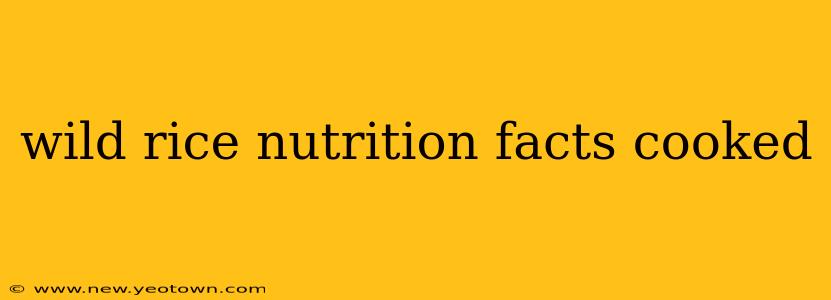Wild rice, often mistaken for a grain but botanically a seed from an aquatic plant, has captivated food lovers for its unique earthy flavor and impressive nutritional profile. This isn't your average side dish; it's a powerhouse of nutrients that can significantly benefit your health. Let's explore the fascinating world of cooked wild rice and uncover its nutritional secrets.
Imagine this: you're preparing a hearty autumn meal, the aroma of roasting vegetables mingling with the subtle nuttiness of cooked wild rice. This isn't just a delicious dish; it's a testament to nature's bounty, providing a wealth of essential vitamins, minerals, and antioxidants. But what exactly makes wild rice so special?
What are the Nutritional Benefits of Cooked Wild Rice?
Cooked wild rice is a nutritional champion. One cup of cooked wild rice boasts a surprising array of benefits:
-
High in Fiber: This is arguably the star of the show. Wild rice is incredibly rich in fiber, aiding in digestion, promoting gut health, and contributing to feelings of fullness, which can be beneficial for weight management.
-
Excellent Source of Magnesium: This essential mineral is crucial for numerous bodily functions, including muscle and nerve function, blood sugar control, and blood pressure regulation. Wild rice provides a significant contribution to your daily magnesium intake.
-
Rich in Manganese: Manganese is an often-overlooked mineral vital for bone health, wound healing, and metabolism. Wild rice is a great source of this important nutrient.
-
Good Source of Phosphorus: Phosphorus plays a key role in energy production, cell growth, and maintaining strong bones. Wild rice adds to your daily phosphorus intake.
-
Packed with Antioxidants: Wild rice contains various antioxidants, protecting your cells from damage caused by free radicals and reducing the risk of chronic diseases.
-
Provides Selenium: This trace mineral is an essential antioxidant with vital roles in thyroid hormone metabolism and immune function.
How Many Calories are in Cooked Wild Rice?
One cup of cooked wild rice contains approximately 216 calories. While this might seem like a moderate calorie count, remember that the fiber content contributes to satiety, potentially aiding in weight management.
Is Wild Rice Gluten-Free?
Yes, wild rice is naturally gluten-free, making it a suitable choice for individuals with celiac disease or gluten sensitivity. However, always check the label to ensure it hasn't been processed in a facility that also handles gluten-containing products.
How Does Wild Rice Compare to Brown Rice and White Rice?
Wild rice stands out from its refined cousins, brown and white rice, in its nutritional density. While all three offer carbohydrates, wild rice significantly surpasses them in fiber, magnesium, manganese, and other essential nutrients. Brown rice holds a middle ground, offering more nutrients than white rice but less than wild rice. White rice, having undergone extensive processing, loses much of its nutritional value.
What are the Potential Downsides of Eating Wild Rice?
While generally considered a healthy food, wild rice does have some potential downsides:
-
Phytic Acid: Like many grains, wild rice contains phytic acid, which can interfere with the absorption of certain minerals. Soaking wild rice before cooking can help reduce phytic acid content.
-
Arsenic Content: Like other grains, wild rice can contain traces of inorganic arsenic. However, the levels are generally considered safe for most people when consumed in moderation.
How Can I Incorporate More Wild Rice into My Diet?
The versatility of wild rice makes it easy to incorporate into various dishes. You can enjoy it as a simple side dish, add it to soups and stews, include it in salads, or even use it as a base for grain bowls. Its unique flavor profile complements both sweet and savory dishes, making it a delicious and nutritious addition to any meal plan.
This exploration of wild rice nutrition facts aims to provide you with a comprehensive understanding of this superfood. Remember that a balanced diet is key, and wild rice, with its rich nutrient profile, can be a valuable addition to your healthy eating plan. Enjoy its unique flavor and reap the rewards of its impressive nutritional benefits.

